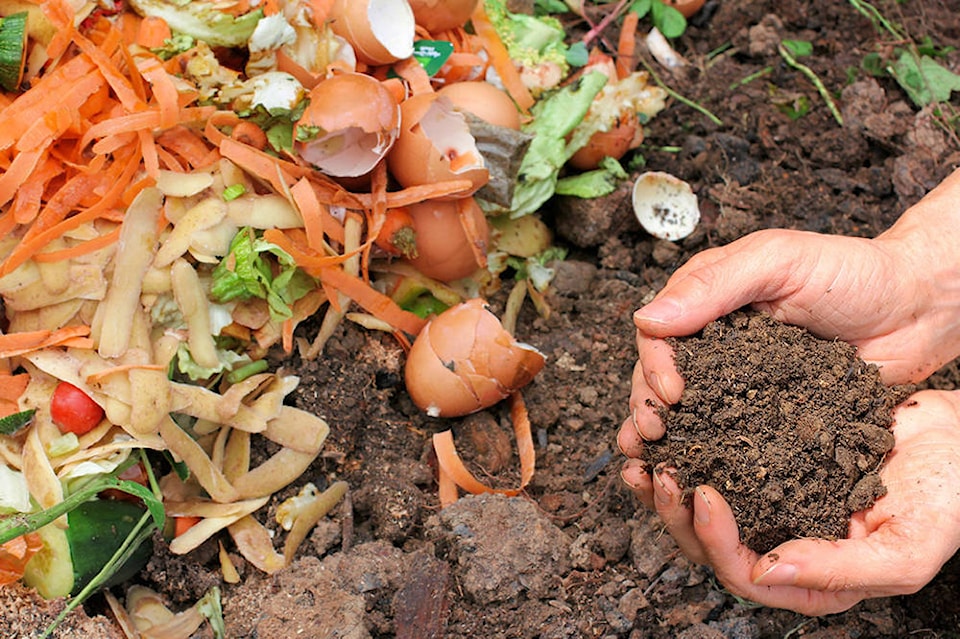Food scraps from businesses and industry in the Regional District of Kootenay Boundary (RDKB) are one step closer to decaying where they belong, now that local government has secured a grant for over $2.3 million to expand the Grand Forks Regional Landfill composting program and has partnered with the Regional District of Kootenay Boundary to implement food scrap collection in east-end jurisdictions as well.
“With this funding in place, we will be the only rural regional district in B.C. that collects and processes all the food waste materials in our region in addition to much of the industrial and commercial organic waste,” said Diane Langman, RDKB Board Chair, in a press release.
The announcement of the successful grant application at a Jan. 30 RDKB board meeting was met with applause and cheers from directors around the table.
Using the money from the grant, along with nearly $1.2 million in RDKB reserve funds, staff will work to upgrade the Grand Forks composting operation by installing impermeable surfaces to protect ground water, adding a collection and control system for leaching, as well as surface and storm water diversion infrastructure. To control the smell of the additional compost, specialized membrane covers will also be installed. The Grand Forks facility will then be able to accommodate industrial, commercial and institutional food waste from across the Boundary, along with wood, yard and garden waste as well.
“What we’ve applied and received grant money for in Grand Forks is for the size of facility that would be required 2o years from now, so that we have lots of room and capacity,” said Janine Dougall, the RDKB’s general manager of environmental services.
In 2018, 513 tonnes of residential food waste and 2,076 tonnes of yard and garden waste were dumped into the Grand Forks facility. The upgrades would allow the site to process a total of 4,000 tonnes per year. Dougall said that waste from industry and commercial enterprises would contribute another 512 tonnes of material to the facility.
The expansion of the landfill’s capacity will also allow for food-waste collection for Greenwood residents – a service that is not currently offered in the city. Dougall said that the design and engineering process would run through 2020, with construction on the upgrades slated for 2021. If on track, Greenwood residents and commercial and industrial entities could expect to begin adding their food scraps to the pile by 2022.
Regional districts partner to divert organics from landfill
The RDKB has also partnered with the Regional District of Central Kootenay (RDCK) to implement curb-side collection of food waste from RDKB Electoral Areas A, B/Lower-Columbia/Old Glory, Rossland, Warfield, Trail, Montrose and Fruitvale, as well as from the cities of Castlegar and Nelson in the RDCK.
Through the same granting stream used for the Grand Forks facility, the RDCK received more than $1.5 million to create an organics composting program too. The RDCK is meant to kick in just over $790,000 more of its own money to the project, while the RDKB would contribute through future tipping fees.
Given that there is currently no household food waste program in east-end jurisdictions, Dougall said, the partnership that would see RDKB organics go to an RDCK facility “is obviously going to make a significant improvement to the waste diversion and waste reduction programs that the Regional District of Kootenay Boundary is doing.”
The general manager of environmental services projected “significant implications for for waste reduction for us, as well as obviously Central Kootenay,” based on the partnership.
“Both our regional districts have declared climate action imperatives, and it makes complete sense to combine forces across the West Kootenay to reduce greenhouse gas emissions from organic waste,” said Aimee Watson, RDCK Board Chair, in a press release. “This program will result in environmental benefits across a large swath of our two regional districts.”
According to RDKB projections, curb-side programs offered to residents in Areas A and B, along with the municipalities of Trail, Rossland, Warfield, Fruitvale and Montrose would account for 1,052 tonnes of compost per year, while industry and commercial contributions could weigh in around 813 tonnes of material per year.
READ MORE: RDKB declares climate action imperative
The doubling down on composting fits into the RDKB’s push towards becoming a carbon-neutral government. While properly composted organic materials do still emit carbon dioxide as they decay in a properly aerated facility, the result is much less potent than the methane that is released when those same organic materials are left buried in a traditional landfill. According to research from Princeton University, methane is up to 30 times more effective as a heat-trapping gas than carbon dioxide.
According to the National Zero Waste Council, an organization formed by some of the largest municipalities in Canada, 63 per cent of the food Canadians toss away, either to compost or to the landfill, could have been eaten. That amounts to nearly 2.2 million tonnes of edible food wasted over a calendar year.
Dougall said that the start of an east-end collection would be dependent on the completion date of the RDCK’s central landfill upgrades. A household composting program in the West Kootenays is slated to be fully operational by spring 2022.
@jensenedw
Jensen.edwards@grandforksgazette.ca
Like us on Facebook and follow us on Twitter.
